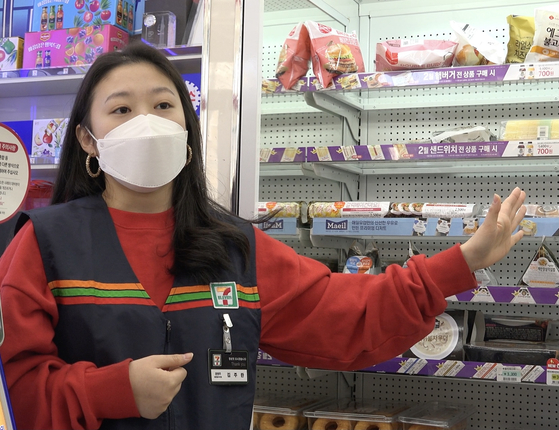#18% of sales through’tray sales’
A 66㎡ (20 pyeong) convenience store in Yonghyeonguldari in Incheon. Convenience store sales in similar commercial districts decreased by 1.9% on average last year due to the novel coronavirus infection (Corona 19), but 7-Eleven’s sales at Yonghyeon Guldari increased by 14.6%. What is the secret that only sales of Yonghyeon Guldari branch increased in the commercial district of housing and academy, where remote classes were held in the aftermath of Corona 19 and the steps of students and parents dropped sharply? On the 9th, Kim Soo-young (33), the store owner, laughed brightly, saying, “The secret to increase sales is’Tray sales’.”
‘Escape the crisis with a small change’… 3 Convenience Store Owners Fighting Corona

Photo 7-Eleven
Store manager Kim paid attention to the’Last Order’ service introduced by the headquarters in February of last year. He turned away from other stores, saying that they can sell valuable products to consumers at a lower price and do not incur additional disposal costs, but other stores are cumbersome. He posted more than 2,000 products, such as lunch boxes and drinks, which are about to expire, on the convenience store app, and notified them to customers. As a result, only products sold through the last order service last year (February-December) posted an average of 50 items per day, about 16.700 items per year, and an average of 350,000 won per day. Store manager Kim said, “When I first explain the last order service to customers, I liked it by saying,’Is there such a thing?’ .
Self-employed people are crowded at the edge of the cliff due to Corona 19. The same is true of convenience stores with more than 60,000 scattered across the country. In some places, sales have improved slightly due to the influence of working from home, but most of them have either stepped back or declined. Sales of single stores in downtown areas and academies, where the floating population declined, decreased by more than two orders of magnitude. However, there are certainly people who have turned the crisis into an opportunity, like store owner Kim.
#18% of customer unit price by introducing’delivery service’
Yoo Se-hoon (34), a store owner of 7-Eleven Incheon Ganseok Market, actively introduced the delivery service. 7-Eleven is operating a delivery service at 3,500 stores nationwide along with’Yogiyo’, and delivery service is also available through ordering KakaoTalk in February. However, not all stores use it because it is a service introduced by the head office. The store owner noted that the customer unit price for customers visiting the store is around 5,000 won, while the purchase amount for delivery service reaches at least 10,000 won per case. So, I communicated with customers by actively publicizing the delivery service and writing comments on store reviews.

Photo 7-Eleven
The number of delivery requests, which was less than 1 per day in the initial delivery service, has now exceeded 10 on average, and the delivery service rating is also 4.9 out of 5 points. Consumers who are satisfied with the online service also visit offline stores in person. Thanks to this, store visitors increased by 10.5% and customer price by 18.4%, respectively, last year. He said, “I think that negative comments are not criticism, but point to improve service,” he said. “We give small gifts such as snacks and ramen to those who comment.”
#10% of sales through’courier service’
Some have captured the hearts of consumers with annoying services that others are reluctant to use. This is the case with the owner of the 53-year-old Gwangju Usan Aze store located in Gwangsan-gu, Gwangju. Owner Cho originally opened a convenience store in 2008 after having been a bakery for a long time here. It is the 14th year this year. Thanks to him, he is bright in the neighborhood. So he didn’t readily refuse to ask for “send a courier” from nearby customers. For the elderly, they also fill out slips and store delivery boxes.

Cho Bang-rae, the owner of 7-Eleven Gwangju Usan Aze. Last year, the sales growth rate reached 10.2% thanks to the kindness of the courier service that other convenience books are cumbersome with. Photo 7-Eleven
In fact, for convenience store owners, parcel delivery is a cumbersome service. The fee per case is only 500 won, and stores are inevitably cramped due to delivery boxes. This is why other convenience store owners are reluctant. His store is also not large, with a scale of 50㎡ (approximately 15 pyeong). However, the store manager Jo said, “Although most convenience stores do courier services, there are not many convenience stores that properly receive courier services from the perspective of consumers,” he said. “I asked you to bring them all instead of saying no.” For foreign customers who couldn’t speak Korean, there was a case where they sent parcels with hand gestures. Thanks to that, the foreign customer has now become a regular customer. Kindness in the body led to achievements. With word of mouth, his store currently handles an average of 120 parcel requests per month. Those who came to drop off the courier come to him even if they buy a small drink or a cigarette. Thanks to this, the Gwangju umbrella shop’s sales growth rate reached 10.2% last year.
Reporter Lee Soo-ki [email protected]
![]()
